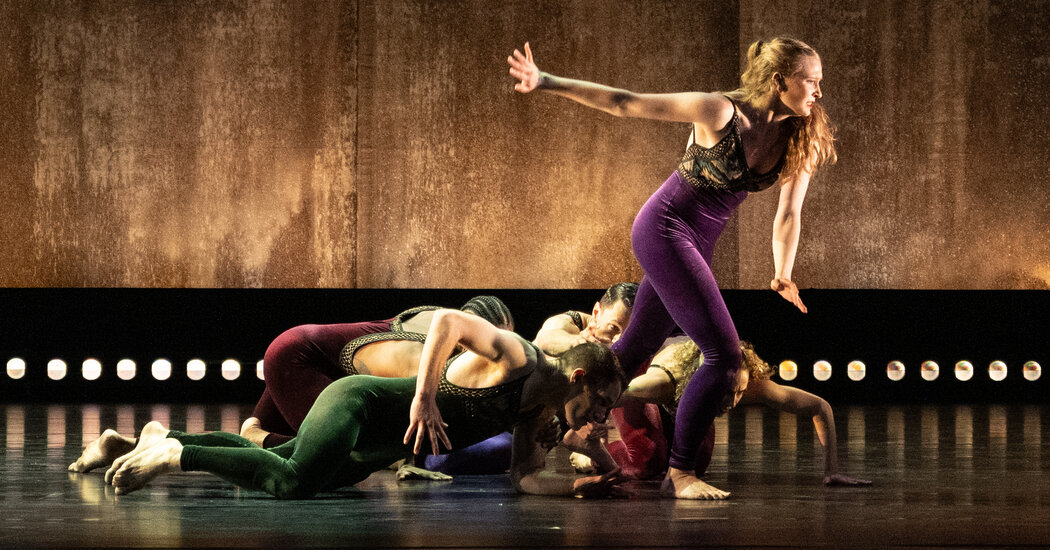Paul Taylor, born during the Great Depression, came to dance late after a difficult childhood. His parents separated, and he was sent to foster care. It must have been crushing to realize, as he wrote in his autobiography, that “affection sometimes needs to be arranged for with hard cash.”
Relying on fortitude and humor through sadness and indignation is in every dance he made. Taylor, who died in 2018, was a keen observer, and his study of people and the natural world was imprinted on those dances — the funny ones, the distressing ones, those that mixed the two. For Taylor, a dance was never just a dance. But when new choreographers come in, a dance too often is just that: a dance.
This week and last, during the Paul Taylor Dance Company’s fall season at Lincoln Center, three commissioned choreographers offered new works: Robert Battle, Hope Boykin and Lauren Lovette. (Battle and Lovette are resident choreographers.) Each of their dances is born from a personal place, yet each lives on or close to the surface, imparting little beyond shapes and steps until, seemingly out of nowhere, a scene of wistful emotion puts in an appearance.
It may be impossible to live up to Taylor, one of the most important choreographers of the 20th century, but a start might be banishing sentimentality.
The most authoritative and impressive premiere was Lovette’s “stim,” a dance for eight named for stimming, or the repetitive actions like tapping or rocking that rest the mind and are related to attention deficit hyperactivity disorder. (Lovette has personal experience with the condition; the dance is a way to embrace herself.)
The theme is apparent from the start when the scintillating Elizabeth Chapa stands before hanging, shimmery fabric. She holds tightly onto a shoulder before her torso twists in a frenzy, and she is dragged under the fabric.
The set and the costumes (jewel-tone velvet unitards) — both by Santo Loquasto — help Lovette to create a cold and confined universe where dancers battle themselves and each other to the whoosh and whirl of John Adams’s frenetic “Fearful Symmetries.”
The fabric rises and falls as Lovette’s movement pours out at a frenzied pace with dancers breaking into jagged, agile solos and duets. Through it all, her vocabulary starts to resemble Taylor 101. There are floor slides, hanging jumps, crawls and spirited runs that echo Taylor’s “Esplanade”; even the costumes hint at the unitards from “Promethean Fire.” It’s like she raided Taylor’s closet and put some of his classic shirts on backward, but without adding enough of her own personal twist.
Lovette has a better command of balancing the sculptural prowess of Taylor’s robust movement with her own anxious, twitchy expressiveness. When it works, she’s onto something. Dancers stand with their feet planted in second position and swing their arms wildly; they cross the space with gutsy purpose, never stopping to catch their breath as the movement accumulates like waves. Mysterious moments surface when dancers seem blind to one another.
The spinning, the shaking, the shuddering comes to an end in a final, fluid solo by Yuniel Betancourt, who closes the work with swiveling hips and imploring arms. Unfortunately, it’s more sappy than calming.
More slight — and hokey — is Battle’s “Under the Rhythm,” another world premiere. Taking its title from a poem by Ermira Mitre Kokomani, the dance for 15 is set to music that includes recordings by Ella Fitzgerald, Wycliffe Gordon and Mahalia Jackson, along with “Clapping Music” by Steve Reich and Russell Hartenberger. Overlaid on “Clapping Music” is the poem, recited by Battle and Dessie Williams, a relative who raised Battle and is the work’s inspiration.
“Under the Rhythm,” which features the dancers mostly in Loquasto’s suspenders, white shirts and bowler hats, is a pastiche of repeated phrase work that opens with the cast standing in a line near the front of the stage performing arm movements to Gordon’s version of “Down by the Riverside,” with its repeated refrain “Ain’t gonna study war no more.”
The dancers move forward and back in lines, eventually raising their arms and pulling them down with a clap, a move that permeates later sections. There are walks in profile with jutting arms and heads that bow down and up; shoulder shimmies and fast turns that transform the dancers into spinning tops with their forearms sticking out from either side of the torso. Battle’s patterns have order, but little complexity.
There’s a jaunty, hip-rocking solo for Jada Pearman to Mahalia Jackson’s “Riverside” and a weighty duet for Devon Louis and Jessica Ferretti to a version of “The Lord’s Prayer.” The mood shifts are swift and a little puerile; instead of it being invigorating, it’s irritating when the company returns for a boisterous finale.
Boykin’s “How Love Sounds,” a New York premiere showing the choreographer at her most open hearted, is also formulaic. Set to a selection of Boykin’s favorite music, including “Patsy Cline’s “True Love” and “I Feel Love” by Donna Summer, the dance offers emotional songs — as well as Dvorak’s Nocturne in B Major, Op 40 — yet never amplifies their inner pulse.
Opening with the Nocturne, couples embrace on a moody stage and one emerges — Lisa Borres Casey and Austin Kelly — cementing their growing desire with a sequence of turns and lift that build to little.
Couples fills the stage searching for and finding pockets of tenderness. John Harnage slumps over with dangling arms as he sways to the line “true love.” In other moments, he cries and laughs maniacally.
More pairs are added, and while responses to songs like Stevie Wonders’s “I Believe” lean into predictability, more cloying are the passages in which Boykin’s text is inserted. The lithe Madelyn Ho responds with passionate bursts of movement to lines like: “My sound my love my whole entire me I want to be. I honor this who I have now become. I want, am, feel … free.”
There was more yearning, though, than feeling free. The Paul Taylor company without Paul Taylor feels like it’s in a regressive place. Michael Novak, the company’s artistic director, has done a fine job maintaining the Taylor repertory, but the premieres feel like they’re being performed on quicksand.
How long until they disappear? Who would miss them? Dances aren’t vessels for personal baggage even when the personal figures in. Taylor wrote: “Sometimes we hear from an artist who has never lost the magical moments of his childhood.” Of the resident choreographers, Lovette has the advantage, but she still has a way to go.
Gia Kourlas is the dance critic for The Times. She writes reviews, essays and feature articles and works on a range of stories.
The post Premieres at the Paul Taylor Dance Company Lose the Taylor Thread appeared first on New York Times.




